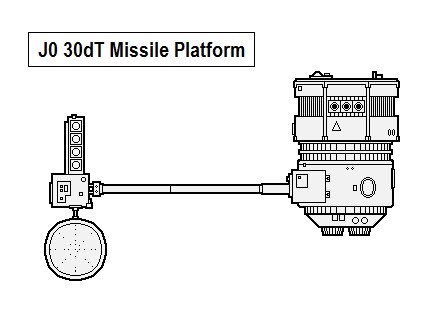Sentinel class Missile Platform
| Sentinel class Missile Platform | |
|---|---|
 Distant Fringe object. | |
| Type: WAH Missile Platform | |
| Category | Smallcraft |
| Size | 30 Tons |
| Hull Configuration | Cylinder Hull |
| Streamlining | Partially Streamlined Hull |
| Tech Level | TL–11 |
| Engineering | |
| Computer | Model/3 fib |
| Jump | J-0 |
| Maneuver | 1 G |
| Armaments | |
| Hardpoints | 1 |
| Accommodations | |
| Staterooms | 0 |
| Personnel | |
| Crew | 0 (automated) |
| High/Mid Passengers | 0 |
| Payload | |
| Cargo | 0.0 Tons |
| Fuel tank | 0 Tons |
| Construction | |
| Origin | Distant Fringe |
| Year Operational | Unknown |
| End of Service | Still in active service. |
| Price | |
| Cost | MCr60.570 (base) MCr48.456 (qty) |
| Architect fee | MCrAde Stewart |
| Statistics | |
| Quick Ship Profile | W-3C10 |
| Images | |
| Blueprint | No |
| Illustration | Yes |
| Source | |
| Also see | Artificial Satellite |
| Canon | Published, fan design |
| Era | 1105 |
| Reference | Fan: Ade Stewart |
| Starships are designed with the Classic Traveller format, using High Guard. | |
The Sentinel class Missile Platform is a satellite.
- It is a paramilitary ship and a small craft.
- Please also see AAB article: Ships of the Distant Fringe.
Description (Specifications)[edit]
The Missile Platform is designed to be a highly survivable orbital weapons platform. Although it is primarily a defense installation, it serves in a secondary role as a communications relay. Its powerful onboard sensor array may occasionally be used as a scientific observatory, typically monitoring weather patterns and stellar conditions. Similar designs have been in use from the time the Distant Fringe was first settled.
- The platform is a TL-11 design.
Image Repository[edit]
General Description & Deck Plans[edit]
No information yet available.
Basic Ship Characteristics[edit]
Following the Imperial Navy and IISS Universal Ship Profile and data, additional information is presented in the format shown here. The small craft factor indicates the number of squadrons (...of ten subcraft) carried on the ship. Tonnage on the universal ship profile is shown in kilotons (...thousands of tons) where necessary. [1]
| Basic Ship Characteristics [2] | ||
|---|---|---|
| No. | Category | Remarks |
| 1. | Tonnage / Hull | The Missile Platform is constructed using a 30 dTon hull built in a generally cylindrical configuration. The hull is partially streamlined, giving a relatively limited atmospheric performance that is reliant on its onboard gravitic systems: the structure rarely leaves its orbital position.
|
| 2. | Crew | Total Crew Complement: 0 (...the Platform is automated). A cramped operations compartment contains facilities for 2 maintenance technicians. Such personnel carry out occasional duties such as refueling, routine maintenance, refreshing onboard supplies, applying software updates and hardware upgrades, and downloading collected data.
Accommodations
Accessible areas of the hull are fitted with grav plates and inertial compensators and have full life support and environmental systems.
|
| 3. | Performance | The platform mounts a Maneuver-1 drive and a Power Plant-4, giving performance of up to 1-G acceleration (though generally the drives are only used for orbital positioning) and producing 1.2 Energy Points. The Platform has an agility rating of 0 and an emergency agility of 1. The internal fuel tankage gives the power plant 7 weeks duration at full combat output: the platform generally operates in a reduced power mode, increasing its endurance exponentially.
|
| 4. | Electronics | The operations compartment contains x2 acceleration couches and control equipment. The platform is run by a largely autonomous Model/3fib Computer: no backup computer is installed.
|
| 5. | Hardpoints | 1 hardpoint. |
| 6. | Armament | The normal weapons fit-out for a Missile Platform is:
x1 triple Missile turret, forming its own battery. These are operated by the onboard computer as necessary.
|
| 7. | Defenses | The hull is heavily plated and structurally reinforced, giving it an armor rating of 11.
The platform is not fitted with screens or other passive defensive systems. |
| 8. | Craft | The platform carries no subcraft. |
| 9. | Fuel Treatment | The platform has internal fuel tankage of 2 dTons.
|
| 10. | Cost | The basic cost of the platform is MCr60.570.
|
| 11. | Construction Time | 24 weeks (5.5 months) as standard.
|
| 12. | Comments | The platform includes an armored missile magazine with a capacity of 1 dTon.
The Missile Platform is operated by an autonomous Model/3fib Computer. It relies in its advanced sensors and threat analysis algorithms to assess potential dangers and deal with them accordingly.
|
History & Background (Dossier)[edit]
The Missile Platform is representative of designs used throughout the Distant Fringe. While it is relatively expensive, it is extremely rugged and durable. Large numbers of variants exist, particularly with regard to the allotted missile complement and the onboard electronics.
- Missile Platforms are generally deployed in small groups, relaying data between each unit.
Distant Fringe Vessels[edit]
The Distant Fringe is said to be a far rimward-trailing area inhabited by colonists and refugees originating on Terra. The region is extremely isolated, lying hundreds of parsecs from the rest of Charted Space and separated from it by almost uncrossable rifts that were once broached by a system of calibration Points and the use of tankers. Those few academics within Charted Space who have found references to the Distant Fringe regard it as little more than a tall tale. Likewise, many of the inhabitants of the Distant Fringe believe the existence of Charted Space to be mythical.[3]
Vessels originating within the Distant Fringe are very rarely encountered outside of the region. However, misjumps do occur and anomalies with bizarre spacetime and Jumpspace effects exist: as such, craft of this type are not entirely unknown within Charted Space. Data about stations and facilities may be known from records found aboard such far-flung craft.[4]
Class Naming Practice/s & Peculiarities[edit]
A number of companies manufacture weapons platforms equivalent to the Sentinel class. They vary in hull shape and internal layout but all share the same basic design and all have very similar capabilities and performance characteristics.
- Each variant class is named by the company that produces it: these organizations generally draw on traditional naming protocols. It is not uncommon for a historical class name to be reused.
- Individual examples of the class are issued specific serial numbers and transponder codes.
Selected Variant Types & Classes[edit]
Artificial Satellites – Space Stations:
References & Contributors (Sources)[edit]
| This article has metadata. |
| This article is missing content for one or more detailed sections. Additional details are required to complete the article. You can help the Traveller Wiki by expanding it. |
- CT Book 5 "High Guard", GDW, 1980. (Design protocols used)
- Author & Contributor: Lord (Marquis) and Master Scout Emeritus Adie Alegoric Stewart of the IISS
- ↑ Timothy B. Brown. Fighting Ships (Game Designers Workshop, 1981), 10.
- ↑ Timothy B. Brown. Fighting Ships (Game Designers Workshop, 1981), 10.
- ↑ Information provided to the library by Maksim-Smelchak
- ↑ Information provided to the library by Maksim-Smelchak
